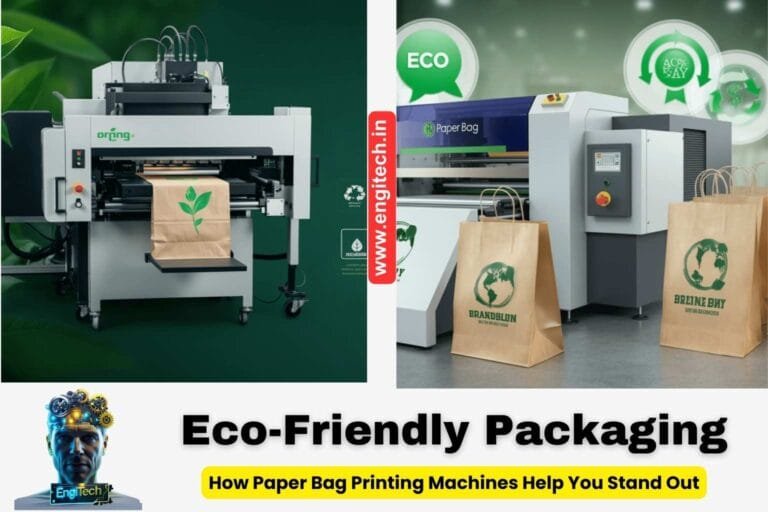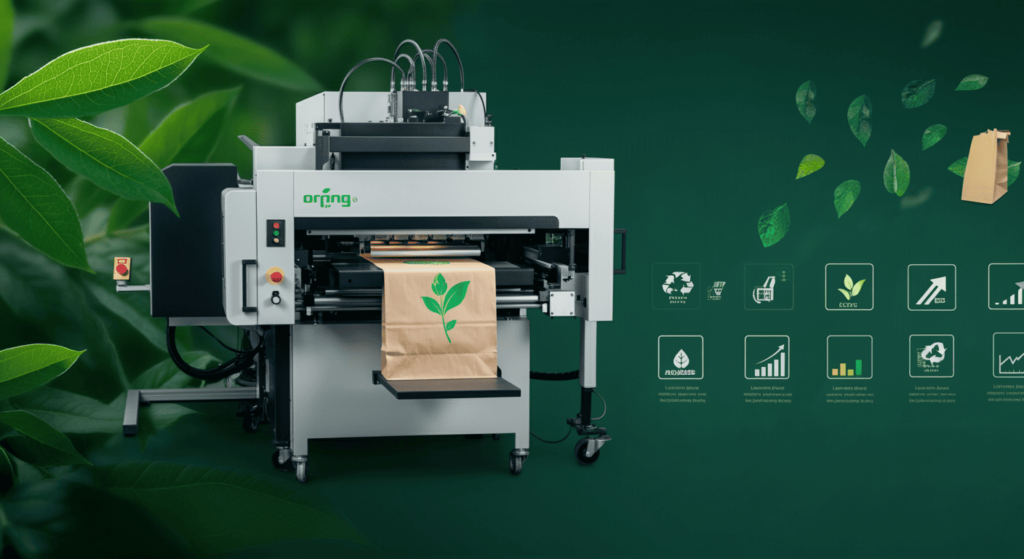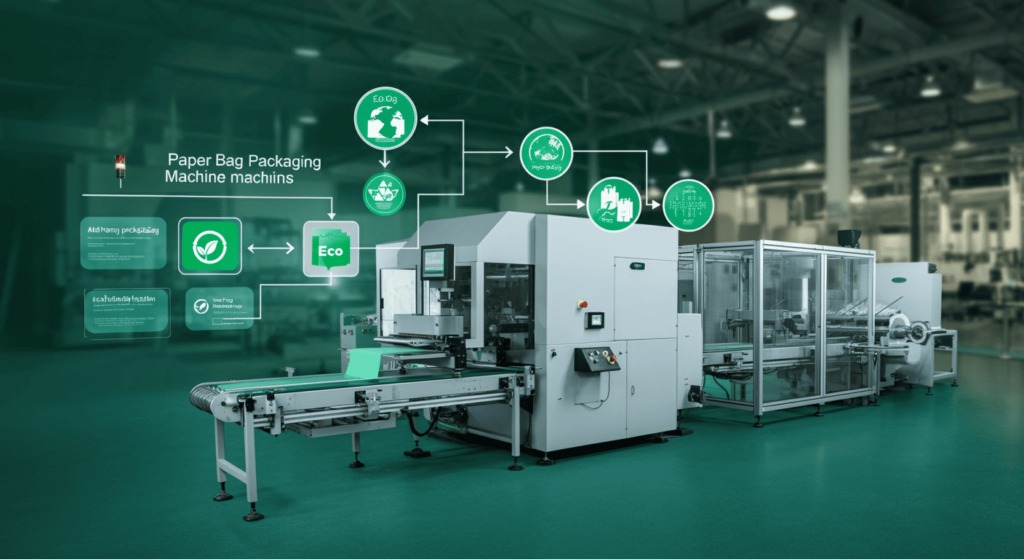
In a world increasingly conscious of environmental impact, the demand for eco-friendly packaging solutions has never been more urgent—or more exciting. Right now, consumers want more than just a product; they crave a brand experience that aligns with their values. If you’re looking to stay ahead of your competition, tap into new audiences, and protect the planet, eco-friendly packaging is the name of the game.
This guide will show you exactly how paper bag printing machines can be the unsung heroes in your quest for sustainability, brand recognition, and growth. By the end of this in-depth exploration, you’ll know how to harness this technology for maximum impact.
Table of Contents
Introduction: The Rise of Eco-Friendly Packaging
Eco-friendly packaging has evolved from a “nice-to-have” option to a non-negotiable element of modern business. Over the past decade, countless consumers have shifted their loyalty to brands that demonstrate responsible practices—particularly in packaging. By using eco-friendly packaging, not only do you reduce your carbon footprint, but you also send a powerful message about your brand’s values.
Think about the times you’ve received a beautifully designed product in a plastic bag. Even if the item inside was top-notch, the plastic packaging may have left a sour note, right? Today’s customers are more likely to trust companies that make an effort to “go green.” This is where paper bag printing machines come into play. These machines enable you to produce aesthetically pleasing, durable, and earth-friendly paper bags that elevate your brand image and stand out from the sea of competitors. In this post, we’ll explore the strategic and practical facets of incorporating paper bag printing into your eco-friendly packaging approach.
Why Paper Bags Matter: A Quick Environmental Snapshot
Before diving into the intricacies of paper bag printing, let’s briefly consider why paper bags hold significant weight in the ecological balance. Research suggests that plastic bags take hundreds to thousands of years to break down in landfills, contributing heavily to pollution and harming marine life. In contrast, paper bags—especially those made from recycled materials—decompose much more quickly and are less harmful to wildlife and ecosystems.
- Reduction in Plastic Waste: Each paper bag you circulate removes a potential plastic bag from entering the environment.
- Renewable Resources: Paper is generally sourced from trees or recycled materials. When managed responsibly (e.g., sustainable forestry), paper can be a renewable resource.
- Biodegradability: Under the right conditions, paper decomposes much faster than plastic, leaving fewer long-term ecological impacts.
By choosing paper bags, you help curb pollution and show responsibility to current and future generations of consumers.

Understanding Paper Bag Printing Machines
The backbone of high-quality paper bag production lies in the technology that prints and assembles them. Paper bag printing machines have evolved over the years to accommodate higher volumes, intricate designs, and varied customization options. These machines can handle everything from straightforward single-color branding to complex, full-color imagery.
3.1 Types of Paper Bag Printing Machines
- Flexographic Printing Machines:
- Utilizes flexible relief plates.
- Best for large runs and simple designs.
- Can handle various inks, including water-based and soy-based options.
- Gravure Printing Machines:
- Offers high-quality, vibrant prints.
- More suitable for massive production scales.
- Tends to be costlier in initial setup but beneficial for huge orders.
- Offset Printing Machines:
- Delivers crisp, detailed images.
- Ideal for shorter runs or specialized paper bags that require complex artwork.
- Ensures high color fidelity.
- Digital Printing Machines:
- Perfect for short runs and quick turnarounds.
- Allows for frequent design changes without incurring huge costs.
- Often used for personalized or event-specific packaging.
3.2 Key Features to Look For
- Printing Speed: Essential for meeting large orders and urgent deadlines.
- Ink Compatibility: Ensuring compatibility with eco-friendly inks can further boost your green credentials.
- Versatility in Paper Types: From kraft paper to specialized textured stocks, the machine should handle multiple substrates.
- Automation Capabilities: Some machines can automatically feed, print, cut, and form bags, saving you time and labor costs.
Identifying the right equipment depends on your budget, production needs, and the complexity of your branding requirements. Flexographic and offset machines remain popular choices for many businesses due to their balance of cost-effectiveness and quality.
Branding and Customization: Standing Out With Paper Bag Printing
Picture this scenario: You walk down a busy street, cup of coffee in one hand, a newly purchased item in the other—wrapped in a paper bag that catches everyone’s eye. This scenario reflects the sheer marketing power of a well-branded paper bag. By transforming a mundane packaging component into a creative brand canvas, you turn every buyer into a walking ambassador for your business.
4.1 Why Branding on Paper Bags Works
- High Visibility: A creatively designed bag stands out in any public setting—on the train, at the gym, or in the office.
- Trust and Credibility: Professionally printed bags suggest professionalism and reliability.
- Retention Value: Customers are more likely to reuse an attractive paper bag, extending your brand’s visibility far beyond a single transaction.
4.2 Creative Design Tactics
- Minimalist Aesthetics: Sometimes, a simple logo and tagline do the trick. Minimalism gives a sense of elegance and sophistication.
- Patterned Designs: You could incorporate subtle patterns, symbols, or icons that resonate with your brand identity (such as leaves, geometric shapes, or cultural motifs).
- Event-Themed Packaging: If you run seasonal promotions, printing holiday or event-specific designs can create instant collector’s items.
4.3 Color and Typography Considerations
Your choice of color and typography can speak volumes about your brand:
- Warm Tones (Reds, Oranges, Yellows): Conveys energy, passion, and approachability.
- Cool Tones (Blues, Greens, Purples): Suggests calmness, professionalism, and nature-friendliness.
- Typography: A modern, clean font can signify innovation, while a classic serif font might communicate tradition and reliability.
In every design decision, consistency is king. Ensure your logo, color scheme, and fonts align with other branding materials—business cards, websites, and social media profiles—to create a cohesive brand experience.
Quality and Sustainability: Striking the Perfect Balance
Consumers are discerning. They don’t just want an eco-friendly bag—they want one that doesn’t tear halfway through the commute. Balancing quality and sustainability requires choosing sturdy paper stock, reliable inks, and a printing process that doesn’t compromise the environment.
5.1 High-Quality Materials vs. Recycled Papers
- Virgin Kraft Paper: Known for its strength and durability, virgin kraft is excellent for carrying heavier goods. However, it involves using freshly sourced wood pulp.
- Recycled Paper: Offers a greener footprint but might be slightly less resilient unless treated with certain reinforcements. Many modern recycled papers are of high quality, though, thanks to improved manufacturing processes.
A hybrid approach often works best: use paper derived from sustainably managed forests or recycled content that has undergone rigorous quality checks. Look for certifications like FSC (Forest Stewardship Council) or SFI (Sustainable Forestry Initiative) to ensure ethical sourcing.
5.2 Optimizing the Printing Process for Durability
A high-quality print doesn’t just look good; it also resists fading, smudging, or peeling. Consider the following:
- Water-Based Inks: Environmentally safer, often made from soy, vegetables, or other renewable resources.
- Appropriate Coatings or Laminates: Eco-friendly coatings can provide additional resistance to moisture and improve bag longevity.
- Advanced Drying Techniques: Certain printing machines come equipped with hot air or IR (infrared) dryers for faster ink drying, preventing smudges.
Proper storage is just as important. Paper bags should be stored in a moisture-controlled environment to maintain their integrity. After all, the only thing worse than a low-quality plastic bag is a low-quality paper bag that tears prematurely.

Cost-Effectiveness: Are Paper Bags Worth the Investment?
A common question that arises is whether investing in paper bag printing machines and eco-friendly materials is actually profitable in the long run. The short answer is a resounding “Yes,” but let’s break down why.
6.1 Analyzing Long-Term Returns
- Enhanced Brand Reputation: Gaining a green reputation can lead to increased customer loyalty and potentially higher sales.
- Reduced Environmental Levies: Some regions impose taxes or restrictions on plastic usage, and switching to paper can save you from fines or levies.
- Lower Marketing Costs: Branded bags are “walking billboards,” which may reduce the need for other advertising expenditures.
While your initial outlay for machines and materials might be higher compared to buying bulk plastic bags, the value you gain in brand visibility and consumer trust often justifies the expense.
6.2 Minimizing Waste for Maximum Savings
Paper production can be waste-intensive if not managed properly. However, modern printing machines often come with efficiency-driven features:
- Automatic Material Feeding: Minimizes paper wastage by only feeding the exact amount needed.
- Recyclable Offcuts: Excess scraps can often be collected and recycled back into new paper products.
- Digital Design Proofs: Allows you to perfect designs without wasting reams of paper in trial runs.
By making strategic choices—like using recycled paper rolls and adopting energy-efficient printing methods—you not only save on operational costs but also underscore your commitment to eco-friendly packaging.
Implementing Paper Bag Printing Machines in Your Business
So, you’ve decided that paper bags are the way to go. Great choice! Now the question becomes: how do you actually integrate these machines into your day-to-day operations?
7.1 In-House vs. Outsourcing
- In-House Production:
- Pros: Full control over quality and production timelines; potential for quick design changes.
- Cons: Requires significant initial investment in machinery, workforce training, and space.
- Outsourcing to Specialized Vendors:
- Pros: Lower upfront costs, professional expertise, and access to diverse design options.
- Cons: Limited control over production schedules; possibly higher per-bag costs in smaller quantities.
A hybrid approach might also be possible: invest in a mid-range printing machine for short runs and specialized bags, while outsourcing bulk orders during peak seasons.
7.2 Training and Operational Tips
- Operator Training: Ensure that your team understands the intricacies of calibration, color matching, and machine maintenance.
- Routine Maintenance Checks: Regular inspections extend the lifespan of your equipment, preventing costly breakdowns.
- Sustainability Best Practices: Encourage staff to minimize paper usage, reuse test prints, and properly recycle waste paper.
- Inventory Management: Keep track of paper rolls, inks, and other supplies so you can anticipate restocks and avoid production downtime.
A smooth in-house printing operation hinges on consistent quality control. Implement standard operating procedures (SOPs) for every step, from design approval to final bag checks, to guarantee that each batch meets (or exceeds) your quality benchmarks.
Case Studies: Brands That Thrived With Eco-Friendly Packaging
8.1 Local Bakery’s Success Story
Picture a small, family-owned bakery located in a bustling downtown area. Their switch from generic plastic bags to branded, eco-friendly paper bags led to:
- A 25% boost in daily foot traffic, driven by word-of-mouth and social media buzz.
- A new revenue stream from selling reusable “collector’s edition” paper bags with seasonal motifs.
- Greater community goodwill and glowing reviews highlighting the bakery’s commitment to sustainability.
The bakery invested in a compact digital paper bag printing machine, which allowed them to experiment with new designs for holidays and special events. Over time, the bakery’s unique, artistic paper bags became part of their signature brand identity.
8.2 A Global Retailer’s Massive Shift to Paper Bags
Now let’s scale up. A multinational fashion retailer replaced plastic shopping bags across their global stores with standardized paper bags. The result?
- Greater Brand Cohesion: Uniform paper bag designs across all stores reinforced brand recognition.
- Positive Environmental Impact: They estimated a reduction of over 200 million plastic bags per year, significantly lowering their carbon footprint.
- Marketing Win: Shoppers often took to social media to post “hauls,” featuring the stylish paper bags in their photos, thus providing free advertising.
While the initial logistics—sourcing massive quantities of paper, investing in high-volume printing machines, and training staff—were complex, the brand saw a long-term ROI in both cost savings and invaluable brand goodwill.

Frequently Asked Questions (FAQ)
Q1: Are paper bags always more eco-friendly than plastic bags?
A1: Generally speaking, paper bags have a lower long-term environmental impact because they are biodegradable and can be sourced from renewable materials. However, factors like production methods and transportation also matter. Sourcing paper from responsibly managed forests or recycled content can further reduce its ecological footprint.
Q2: Does printing on paper bags compromise recyclability?
A2: Most modern inks, especially water-based or soy-based varieties, do not significantly impact the recyclability of paper bags. Always confirm ink types and adhesives with your printing machine manufacturer or supplier to ensure the bag remains recyclable.
Q3: Can small businesses afford to invest in their own paper bag printing machine?
A3: Yes, there are entry-level and mid-range machines designed for smaller production runs. Although you’ll need to budget for training, maintenance, and space, the long-term branding and eco-friendly benefits can outweigh the initial costs.
Q4: What if I need glossy or laminated paper bags?
A4: Glossy or laminated finishes often involve additional coatings. Some are eco-friendlier than others. Look for water-based varnishes or biodegradable laminates that won’t hinder the bag’s recyclability.
Q5: How do I measure the success of switching to paper bag packaging?
A5: Metrics can include increased brand awareness, social media engagement (people often share aesthetically pleasing bags), foot traffic to physical stores, and online feedback. Additionally, track changes in sales or customer loyalty programs to see if there’s an uptick following the adoption of eco-friendly packaging.
Going Beyond the Bag: Future Trends in Eco-Friendly Packaging
Adopting paper bag printing machines is a critical first step, but the world of eco-friendly packaging continues to evolve. Staying ahead requires awareness of emerging trends that fuse environmental responsibility with innovation.
10.1 Biodegradable Coatings
Though paper is biodegradable, certain necessary finishes can interfere with that process. New coatings derived from natural materials like cornstarch and potato starch aim to protect the bag while still allowing it to decompose efficiently. These coatings can improve water resistance without compromising recyclability or contributing to microplastic pollution.
10.2 Smart Packaging Technologies
Imagine scanning a paper bag with your smartphone to instantly view product information, promotions, or sustainability data. Near Field Communication (NFC) and Quick Response (QR) codes offer interactive touchpoints with consumers, bridging the gap between the physical and digital worlds. Although it’s still a growing field, integrating these smart features into your paper bags can significantly enhance customer engagement.
Conclusion: Your Next Step in Sustainable Branding
We’ve journeyed through the ins and outs of eco-friendly packaging and how paper bag printing machines can revolutionize your brand presence. From selecting the right machine type and design approach to implementing best practices and exploring future trends, it’s clear that paper bags aren’t just a trend. They are a credible, meaningful path toward sustainable business growth.
Ultimately, investing in paper bag printing yields multiple payoffs—stronger brand loyalty, decreased environmental harm, and a tangible demonstration of your commitment to ethical practices. In a marketplace where consumers are increasingly vocal about eco-conscious choices, those who embrace responsible packaging stand out from the crowd.
Ready to transform your packaging strategy?
- Start by evaluating your budget and capacity for an in-house or outsourced approach.
- Align design elements with your brand’s story, ensuring consistency across all marketing channels.
- Train your team or work with reputable partners to guarantee top-notch quality and timely fulfillment.
By taking these steps, you won’t just meet consumer demand for eco-friendly packaging—you’ll exceed their expectations and secure a loyal following that appreciates your forward-thinking vision. Embrace the power of eco-friendly packaging and leverage paper bag printing machines to help your brand truly stand out.
Eco-Friendly Packaging: How Paper Bag Printing Machines Help You Stand Out—this isn’t just a catchphrase. It’s a blueprint for modern businesses seeking to thrive in a rapidly changing, sustainability-driven world. Make the leap and watch as your brand reaps the rewards of an authentic commitment to both quality and the environment.
Are you prepared to elevate your brand and make a lasting impact with eco-friendly packaging? Share your thoughts, experiences, or questions in the comments below. And don’t forget to spread the word! Together, we can create a greener, more innovative future—one beautifully printed paper bag at a time.
Stay Connected with EngiTech
EngiTech is your trusted source for in-depth knowledge on industrial mechanical engineering machines and technologies. Stay ahead with the latest innovations, expert insights, and practical guides designed to help you make informed decisions for your business and engineering needs. Join our growing community of professionals and industry leaders to stay updated and competitive in the ever-evolving world of industrial technology.